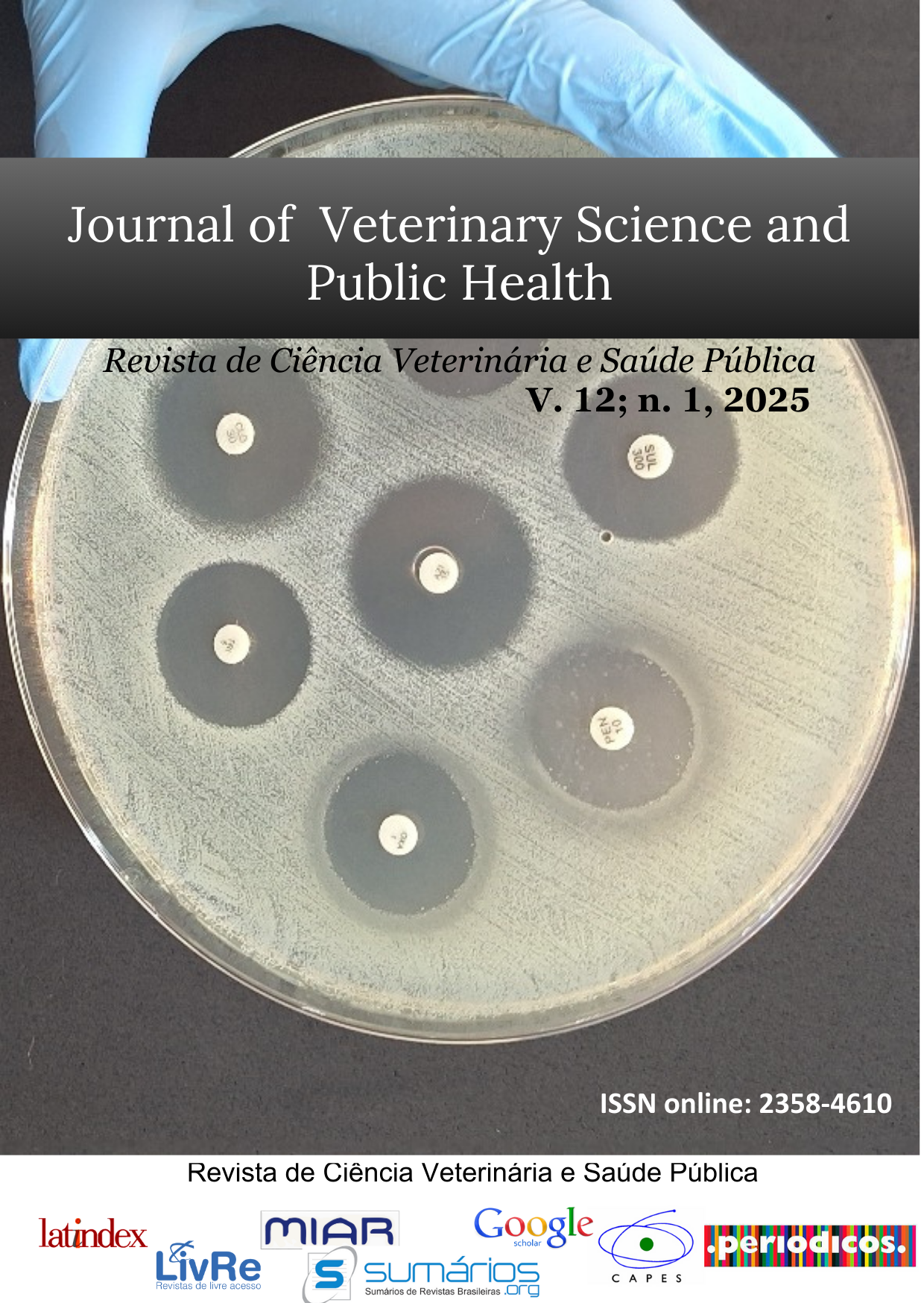Pharmacodynamic effects of intranasal ketamine in cats
Abstract
Ketamine is a versatile drug that is widely used in various clinical contexts. It is commonly administered intravenously, but several studies have shown that it can be used by alternative routes, such as intranasal. The aim of this study was to evaluate the cardiovascular, respiratory and sedative effects of ketamine after intranasal administration in cats. The experiment was carried out with six cats (n = 6) subdivided into intravenous (IV) and intranasal (IN) groups, which received ketamine at doses of 2 mg/kg and 5 mg/kg, respectively. The physiological parameters and degree of sedation of the animals were assessed before and after administration of the drug. The data was submitted to statistical analysis using the Shapiro-Wilk test and the Kruskal-Wallis test, as well as a descriptive evaluation. The results showed similar effects between the two treatments (p > 0.05), with the sedation score being significantly different for the IV group up to 20 minutes after ketamine administration. The main adverse effect observed immediately after intranasal administration of ketamine was salivation, while with intravenous administration it was mydriasis and muscle rigidity. Ketamine is a drug with a wide therapeutic window and the visualization of its effects varies according to the dose used. The physiological and sedative effects of ketamine were similar between the intranasal and intravenous groups, and there were no relevant changes compared to baseline values.
KEYWORDS: Felis catus, Drug Administration Routes, N-methyl D-aspartate, sedation
Downloads
References
BURNETT, A.M.; PETERSON, B.K.; STELLPFLUG, S.J.; ENGEBRETSEN, M.K.; GLASRUD, K.J.; MARKS, J.; FRASCONE, R.J. The association between ketamine given for prehospital chemical restraint with intubation and hospital admission. American Journal of Emergency Medicine, v.33, p.76–79, 2015.
CONWAY, J. A. et al. Ketamine Use for Tracheal Intubation in Critically Ill Children Is Associated With a Lower Occurrence of Adverse Hemodynamic Events. Critical Care Medicine, v. 48, n. 6, 2020.
DENG, M.; CHEN, S.; PAN, H. Presynaptic NMDA receptors control nociceptive transmission at the spinal cord level in neuropathic pain. Cellular and Molecular Life Sciences, v.76, p.1889–1899, 2019.
ERDŐ, F.; BORS, L.A.; FARKAS, D.; BAJZA, A.; GIZURARSON, S. Evaluation of intranasal delivery route of drug administration for brain targeting. Brain Research Bulletin, v.143, p.155-170, 2018.
BOUVIER, G.; BIDORET, C.; CASADO, M.; PAOLETTI, P. NEUROSCIENCE FOREFRONT REVIEW PRESYNAPTIC NMDA RECEPTORS: ROLES AND RULES. Neuroscience, p.322-340, 2015.
GUTHRIE, A.M.; REGAN A. BAUM, R.A.; CARTER, C.; DUGAN, A. JONES, L.; TACKETT, T.; M. BAILEY, A.M. Use of Intranasal Ketamine in Pediatric Patients in the Emergency Department. Pediatric Emergency Care, v.00, n.00, 2019.
JELEN, L.A.; ALLAN H YOUNG, A.H.; M STONE, J.M. Ketamine: A tale of two enantiomers. Journal of Psychopharmacology, v.35, n.2, p.109-123, 2021.
LI, L.; VLISIDES, P.E. Ketamine: 50 Years of Modulating the Mind. Frontiers in Human Neuroscience, v.29, 2016.
LOCHHEAD, J.J.; DAVIS, T.P. Perivascular and Perineural Pathways Involved in Brain Delivery and Distribution of Drugs after Intranasal Administration. Pharmaceutics, v.11, 2019.
LUNGARE, S.; BOWEN, J.; BADHAN, R. Development and Evaluation of a Novel Intranasal Spray for the Delivery of Amantadine. Journal of Pharmaceutical Sciences, v.105, n.3, p.1209-1220, 2016.
MARJANI, M.; VAHID AKBARINEJAD, V.; BAGHERI, M. Comparison of intranasal and intramuscular ketamine midazolam combination in cats. Veterinary Anaesthesia and Analgesia, v.42, p.178–181, 2015.
PELTONIEMI, M.A.; HAGELBERG, N.M.; OLKKOLA, K.T.; SAARI, T.I. Ketamine: A Review of Clinical Pharmacokinetics and Pharmacodynamics in Anesthesia and Pain Therapy. Clinical Pharmacokinetics, 2016. DOI 10.1007/s40262-016-0383-6
MCINTYRE, R.S. et al. Synthesizing the Evidence for Ketamine and Esketamine in Treatment-Resistant Depression: An International Expert Opinion on the Available Evidence and Implementation. American Journal of Psychiatry, v.178, n.5, p.383-399, 2021.
MILLER, A.C; JAMIN, C.T.; ELAMIN, E.M. Continuous intravenous infusion of ketamine for maintenance sedation. Minerva Anestesiologica, v.77, n.8, 2011.
MOHRIEN, K.M.; JONES, G.M.; MACDERMOTT, J.R.; MURPHY, C.V. Remifentanil, Ketamine, and Fospropofol A Review of Alterative Continuous Infusion Agents for Sedation in the Critically Ill. CRITICAL CARE NURSING QUARTERLY, v.37, n.2, p.137–151, 2014.
NOWACKA, A.; BORCZYK, M. Ketamine applications beyond anesthesia – A literature review. European Journal of Pharmacology, v.860, 2019.
POONAI, N.; CANTON, K.; ALI, S.; HENDRIK, S.; SHAH, A.; MILLER, M.; JOUBERT, G.; RIEDER, M.; HARTLING, L. Intranasal ketamine for procedural sedation and analgesia in children: A systematic review. PLoS ONE, v.12, n.3, 2017.
RACHED-D'ASTOUS, S.; FINKELSTEIN, Y.; BAILEY, B.; MARQUIS, C.; LEBEL, D.; DESJARDINS, M.; TROTTIER, E.D. Intranasal ketamine for procedural sedation in children: An open-label multicenter clinical trial. American Journal of Emergency Medicine, v.67, p.10–16, 2023.
RADVANSKY, B.M.; PURI, S.; ANTHONY N. SIFONIOS, A.N.; ELOY, J.D.; LE, V. Ketamine—A Narrative Review of Its Uses in Medicine. American Journal of Therapeutics, v.0, p.1–13, 2015.
SAWYNOK, J. Topical and Peripheral Ketamine as an Analgesic. Survey of Anesthesiology, v.119, n.1, p.170-178, 2014. DOI:10.1213/ANE.0000000000000246
TRAYNOR, K. Esketamine nasal spray approved for treatment-resistant depression. American Journal of Health-System Pharmacy, v.76, n.9, 2019.
VLERICK, L.; DEVREESE, M.; PEREMANS, K.; DOCKX, R.; CROUBELS, S.; DUCHATEAU, L.; POLIS, I. Pharmacokinetics, absolute bioavailability and tolerability of ketamine after intranasal administration to dexmedetomidine sedated dogs. PLoS ONE, v.15, 2020.
XIONG, J.; LIPSITZ, O.; CHEN-LI, D.; ROSENBLAT, J.D.; RODRIGUES, N.B.; CARVALHO, I.; LUI, L.M.W.; GILL, H.; NARSI, F.; MANSUR, R.B.; LEE, Y.; MCINTYRE, R.S. The acute antisuicidal effects of single-dose intravenous ketamine and intranasal esketamine in individuals with major depression and bipolar disorders: A systematic review and meta-analysis. Journal of Psychiatric Research, v.134, p.57-68, 2021.








